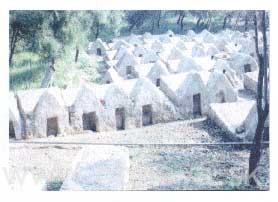Top Twenty 20th Century Heritage Sites within the UK

20th Century Heritage
ICOMOS-UK publishes its list of
Top Twenty 20th Century Heritage Sites within the UK.
The list is part of an ICOMOS world-wide survey which aims to promote understanding of the full diversity of 20th century heritage and to highlight the issues relating to its recognition and conservation.
The ICOMOS-UK list has been compiled with help from English Heritage, CADW (Welsh Historic Monuments), Historic Scotland, the 20th Century Society and the Association for Industrial Archaeology, but reflects the views of ICOMOS-UK alone. The list has no official or statutory basis, nor is it in order of importance: rather it is an attempt by ICOMOS-UK, in response to growing interest in this subject, to add to the international drive for greater recognition and protection as well as to contribute to the debate on how we define what is of value and significance from the 20th century.
20th century heritage is often seen as too close to the present day to allow selection by the perspective of history. It is also seen by some as being too plentiful, creating problems for establishing conservation priorities. Furthermore sophisticated designs and often experimental technologies give it added vulnerability. For all these reasons, the heritage of the 20th century suffers from lack of recognition and protection especially when compared to ‚older‘ or more traditional heritage.
The List:
The ICOMOS-UK list reflects the wide diversity of 20th Century Heritage and some of the main social and economic trends of the century.
Social housing
The great, designed, social housing schemes built in response to changing social and industrial pressures, are reflected by Letchworth Garden City, the first garden city in Hertfordshire built from 1903 by Parker and Unwin, by Cumbernauld New Town built between 1963 to the mid 1970s, the initial phases by Geoffrey Copcutt, and most recently by the innovative public housing of the Byker Estate in Newcastle Upon Tyne, built between 1970 and 1981 by Ralph Erskine. All of these have fed off each other and together reflect the re-writing of so much of the urban landscape that took place in the last century.
Industrial monuments
The industrial wealth of Wales is represented by the monumental Penallta Colliery Engine Hall and Fan House, Caerphilly, built between 1905 and 1909, at the height on the South Wales coal trade to a staggering size of 100 by 23 metres. It had a significant influence on colliery buildings all over Britain. Other industrial monuments are the Lovell Telescope, near Macclesfield Cheshire, 1952-7 and the Cruchan and Hollow Mountain Hydro-Electric Power Station, Argyll, completed in 1965.
Cathedrals
Perhaps more predictable are the last two great cathedral building projects – the Liverpool Anglican Cathedral from 1902-79, to the designs of Sir Giles Gilbert Scott, and the re-built Coventry Cathedral by Sir Basil Spence and Partners.
Classical modern buildings
Buildings associated with the classical modem style are in the minority – the list nevertheless includes key buildings such as Impington Village College school building, 1938-9 to the designs of Walter Gropius, a major figure in the modem movement, working with E Maxwell Fry, and the De La Warr Pavilion at Bexhill, East Sussex, the first, major, public building in the International style in Britain built in 1935 to the designs of Erich Mendelsohn and Serge Chermayeff
Private houses
Only two private houses make the list – Marsh Court, near Stockbridge, Hampshire, by Edwin Luytens, built 1901-4 and Hill House, Glasgow, 1902, part of a group listing of the works of Charles Rennie Mackintosh in Glasgow. The dearth of private houses compared to lists from say the 19th and 18th centuries reflects the shift from private to industrial and institutional clients.
World Heritage
Two sites, the Forth Railway and Road Bridges, engineers Mott, May and Anderson, 1958-64 and the Liverpool Pier Head Buildings (the Royal Liver Building, 1908-10 by W Aubrey Thomas, the Cunard Building, 1913-16 by Willinck and Thickness, and the Mersey Docks and Harbour Board Offices, 1907 by ArnolfThornley and others) are already included on the Government’s Tentative list of World Heritage Sites. Perhaps the list as a whole could be seen as highlighting other buildings or assemblies of buildings which may in the future be considered for inclusion in future tentative lists. There is for instance much interest in other parts of the world in the extensive legacy of garden suburbs in the UK.
Recent debate on what should or should not be put forward for World Heritage status from the 20th century has been given a boost by a suggestion from a leading historian of 20th century architecture that Camden, London, with its rich and dense assembly of 20th century buildings should be considered as a potential World Heritage site.
Absentee:
Notable in the list is the absence of buildings which, despite being of national importance, (and listed appropriately), have failed to survive. An example is the Brynmawr Rubber Factory, Brynmawr, Gwent, listed Grade 11* which would certainly have been on the list had it not been demolished only in mid-2001. If a building as spectacular as this – built by Ove Arup & Partners 1946-51 – can be lost, in spite of enormous local efforts to find a new use for it, then there is a need for more public debate on how we sustain our 20th century heritage.
Quote:
Sherban Cantacuzino, President Emeritus of ICOMOS-UK and former executive editor of the Architectural Review, sums up the significance of the list as
„lying in the way it clearly acknowledges what distinguishes the twentieth century from any other – the pre-eminence of planning and the dedication to a social programme – whilst not forgetting the works of the great architects and engineers of the century „.
zdroj: ICOMOS Slovakia

